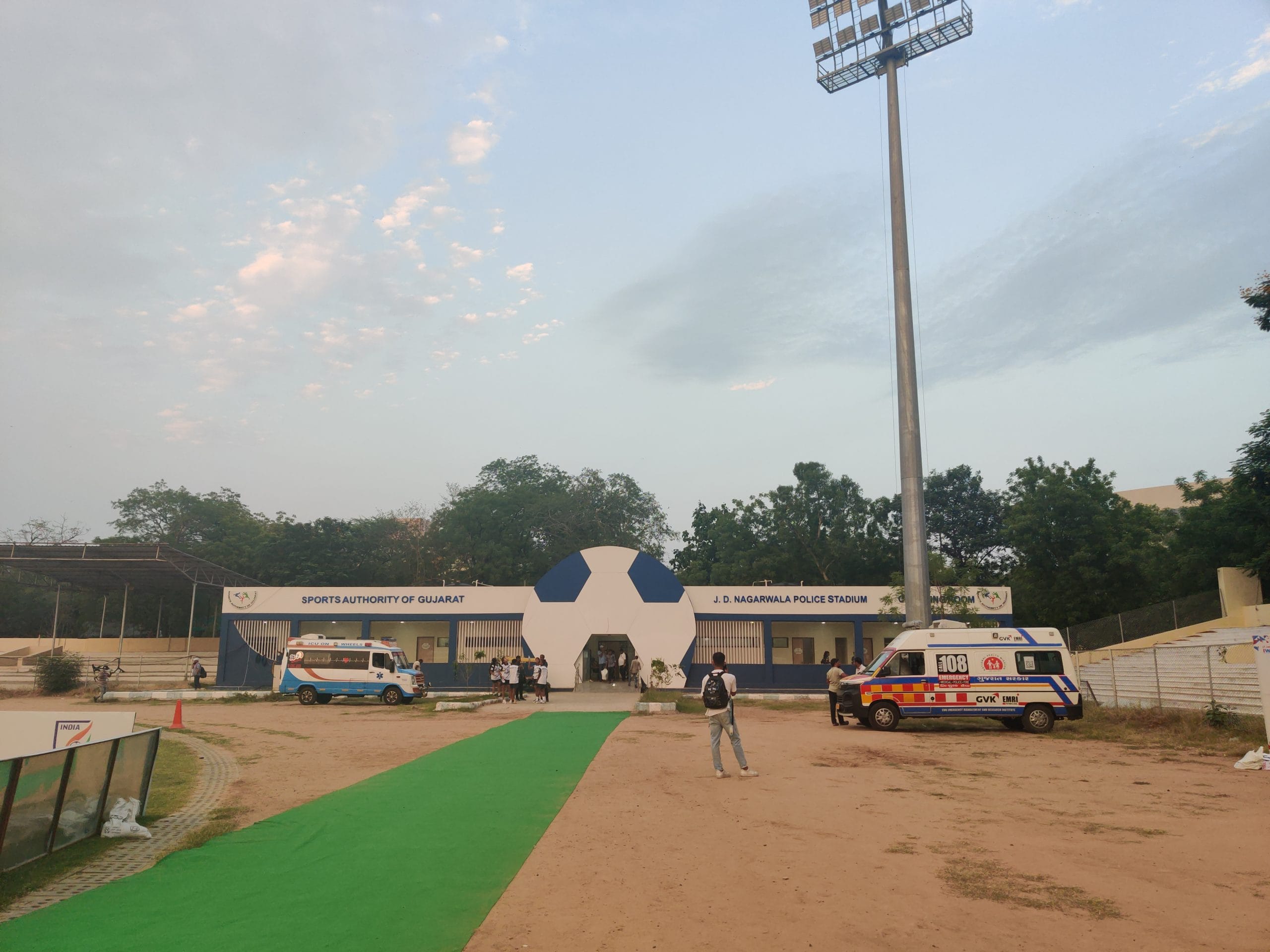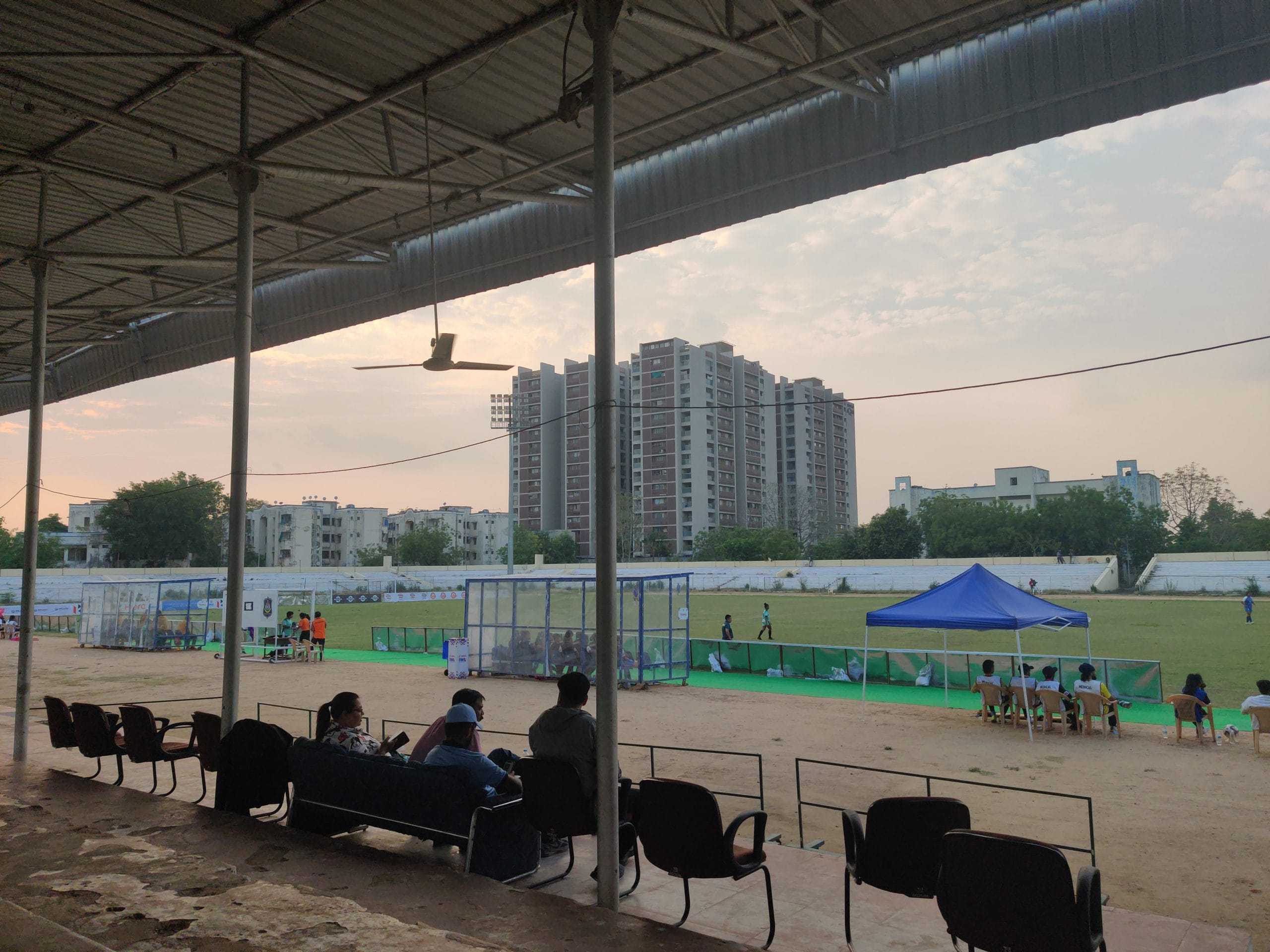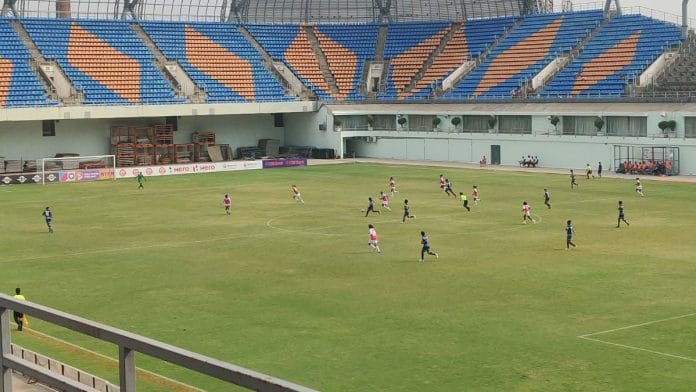Ahmedabad: When Kolkata Knight Riders’ Rinku Singh hit a hattrick of sixes and added two more to it against the Gujarat Titans at Ahmedabad’s Narendra Modi Stadium, the fans, both present and those watching on TV sets, were an exhilarated lot. The video has garnered millions of views since then, with the swashbuckling batter even getting a call from superstar Rajinikanth praising his performance.
Few weeks later and barely 5 km away from the Modi stadium, another thrilling performance was on display. This time on a football ground. Philippines midfielder Camille Rodriguez made a startling debut in the Indian Women’s League (IWL) and scored a hat-trick in her first match against Celtic Queens on 27 April. However, her remarkable achievement and skill at display for Lord’s FA Kochi will remain archived only in the memory of a handful of players and spectators present at the grounds at Shahibaug that morning.
Into its sixth edition now, the Hero Indian Women’s League (IWL)—the top division women’s professional football league in the country—is a month-long saga that tells everything that’s wrong with women’s football in India. No broadcaster, live streaming for only late afternoon matches, inadequate living facilities, and no breathing space between matches being played under the scorching Ahmedabad sun, IWL is struggling to match the standards of a professional sporting tournament. Organised by the All India Football Federation (AIFF) the League is restricted two venues in Ahmedabad.
“There are 16 teams in the league and they all must be treated equally. But one group has adequate accommodation in Ahmedabad while the other is given a group housing over 30 km away from the stadiums. The clubs have no say in the matter,” says a coach, requesting anonymity, of a team participating in the IWL.
While teams such as Eastern Sporting Union, Mumbai Knights, HOPS FC, Sports Odisha and few others are staying in Palaj area, some other clubs have been assigned accommodation in Ahmedabad city, which is closer to the playing venues.

Also read: Dream11 to PokerBaazi—Indians have a new online gaming addiction. And they are losing big
No time for recovery
The young woman foootballers spring into action as soon as the clock strikes 4am. The exhaustion from the late afternoon match, the day before, hasn’t subsided yet but the players have no choice. The sun is yet to rise but they must not waste a minute if they have to make it to for the 8 am match to the stadium in Ahmedabad, some 32 kilometers away from their accommodation in Gandhinagar.
By 5-5:30 am, the team of 30 women footballers that includes the extras along with their coaches and support staff leave the Jeet Residency, located in the Palaj village of Gandhinagar district. The residency is parked miles away from the main city, with scanty population living around. There is no ground in and around the premises for training and the coaches often take the players out on the roads for their morning run.
During their hour-long journey, some players catch up on their sleep, some brainstorm match strategies while others, especially those travelling to Gujarat for the first time, remain glued to their windows.
Their off days don’t take them away from the grill of training. It’s the tournament’s schedule, stupid. And if they still have some time by themselves, they catch up on their sleep.
When there is a morning match, the day begins as early as 4 am. While the first half of the game is easier, the second half becomes increasingly difficult as the temperature rises. The heat is at its worst during the late afternoon matches that begin at 4:30 pm. Temperatures go up to 42-43 degree celsius with sweltering heatwaves doing rounds.
Two 30-second cooling breaks in each half offer momentary solace but playing in such harsh conditions is an uphill battle, especially when the players aren’t well rested from the night before.
The exhaustion that creeps in after over 90-minute play time under unforgiving heat does not usually fade away after a few hours of sleep the same day. This forces the teams to frequently rotate players despite the form. In tandem, it cuts down on the playing time for each player. But the players have no choice.
The teams lodged in Jeet Residency have it worse. The group housing has two teams staying together in each building but the players are not allowed to spend time with other teams. “They made us sign a form before coming in that we must not socialise with other teams,” says a team’s manager requesting anonymity.
Even if the clubs can afford better living facilities, they are not allowed to do so by the AIFF.
And it’s not just the accommodation. The food usually comprises lentils, chapatis, rice, and sabzi, which is served in a pandal outside the building. And if players want to consume nonvegetarian meals, they better order from a food delivery app such as Zomato or Swiggy and eat it outside the residential building.
“The protein intake is not up to the mark, as it must be for athletes,” says a player.
Also read: Blinkit deliverymen would rather work for Uber-Ola, run YouTube channels. Dignity comes first
A shorter league means less match practice
A young footballer sits in the stands as her team plays a late afternoon match at the J.D. Nagarwal Police Stadium in Shahibaug. A month ago, when she learned she would be travelling to Gujarat to participate in the Indian Women’s League for the first time, she was over the moon.
But an unfortunate injury forced her out of her team’s playing XI after participating in two matches. She hoped to recover soon from the knee sprain but by the time she would be fit to play, the tournament will be over.
The ongoing edition of IWL began on 26 April and the group matches will be played till 13 May, followed by the quarterfinals, semi-finals, and the final match. The dates for the knockout matches are yet to be announced.
Two matches are played every day across two venues — J.D. Nagarwal Police Stadium and TransStadia — in Ahmedabad. The late afternoon matches that begin at 4:30 pm are live-streamed on Indian Football’s YouTube channel, while the morning matches are not.
Contrast this with the top tier men’s football league in the country.
The Indian Super League, the professional football league for men’s football, was held from October 2022 to March 2023 under the floodlights across Kochi, Bengaluru, Pune, Chennai, Mumbai, Bhubaneshwar, Kolkata, Jamshedpur, Goa, Hyderabad, and Guwahati. The matches were broadcast on STAR Sports 2 and Star Sports 1 channels in India.
The IWL is being held in one of the hottest months in Ahmedabad with even fewer matches than its previous edition. The players who fall prey to injuries have no time to bounce back, and the ones who are exhausted have no time to recover.
“Infrastructure and structure to the tournament are very important. Last year, IWL was held for 45 days but this year, it is just for 25 days. There is no structure. No home or away games. No exposure that usually comes into the professional tournament,” Dalima Chhibber, who also plays for the Indian national team and is the captain for Kickstart FC in the ongoing IWL season, told ThePrint.
At first when ThePrint reached out to the AIFF, the governing body refused to comment on the IWL schedule and timings as it “creates controversy”. Later, in an email interaction, the federation said that the calendar for IWL could only be finalised by October 2022 as the women’s national teams across different age groups had “international commitments” and hence, “slots for the league could not be found”. As for this year’s short season, AIFF spokesperson Jaydeep Basu says that the 2023 is “serving as a qualifier” to identify the eight teams who will be part of the “bigger league” next year.
Also read: At Yol, it’s not just a cantonment being dismantled. A town is getting divided
No broadcaster
The morning matches are not live-streamed. Only the fixtures held in the late afternoon go live. Where? On Indian Football’s YouTube channel. Because there are no broadcasters on board.
The AIFF floated the tender for broadcasting on 21 April, just four days before the sixth edition of IWL commenced. But no broadcaster was finalised.
“We already have vendors for production listed with us for other competitions. When we looked into our budget, we found that we did not have specific prices for specific levels of production. We floated this tender to acquire that. There is no other reason,” says an AIFF spokesperson.

The federation further explained that its marketing partners identify the broadcasters, and for “various reasons”, local broadcasters could also not be brought on board. Hence, the decision to stream it live on YouTube.
But then why just afternoon matches?
The “budgetary constraints” drove the decision behind streaming half of the games. According to AIFF, the evening slot is “better for fans to engage and watch the games”.
Playing for Lord’s FA, the 28-year-old Rodriguez has seven goals to her credit, making her the third-highest goal-scorer in the league. Her family, who she describes as her “biggest support system”, could not watch her debut match along with other morning matches.
“I wish they broadcast all the games so that my family could see me play,” says Rodriguez, who has been part of the national team since she was 14.
Live matches or match footage are not just important to engage fans but is a crucial part of player assessment and match strategies, say a group of coaches and managers who came to watch the morning match between Celtic Queens FC and Kickstart FC Karnataka at TransStadia on 6 May.
“If there is no recording of the match, how can performance of players be evaluated? The tight schedule does not allow us to watch other team’s performances but it is a crucial part of any competition,” says a coach, requesting anonymity. A second later, she high-fives her colleague as her team scores another goal that would brighten up the chances for her team to advance in the league.
Also read: Hajj frauds, umrah scams are trapping Indian Muslims. Pay and get ghosted
Minimum wage, bids for new teams
On 14 April, twelve days before the IWL season kicked off this year, AIFF announced a minimum wage of Rs 3.2 lakh per season for women football players in the league, as well as a youth developmental platform called ‘Project Diamond’, that would aggregate the best youth players from ISL, I-League and AIFF Elite Clubs.
However, the minimum wage will be applicable from the 2023-24 season.
“It is only applicable to the eight clubs who will participate in the IWL next season. These clubs will also have to mandatorily fulfill the AFC licensing criteria, therefore there will not be any big or small clubs. All clubs that are part of the IWL will have the same licensing criteria,” says AIFF secretary general Dr Shaji Prabhakaran.
Nearly ten days into the sixth edition, AIFF said that it would be inviting bids for direct entry in the IWL if, as expected, teams pull out of the next edition due to an additional financial burden. The next season will also be played on a home-and-away format for the first time.
The Federation will invite bids of Rs two crore (minimum) for direct entry. The companies applying for the bids are mandated to have a minimum net worth of Rs 50 crore.
The clubs with bigger pockets are expected to brave through this change but the same cannot be said for the smaller clubs.
“We don’t have big sponsors backing us up. The club is running on collective effort and on the goodwill of the people around us. We cannot afford that kind of money. There should be a salary package defined for players from AIFF’s end, as it is in cricket,” says a club owner, requesting anonymity.
He points out that the prize money for the league is Rs 10 lakh for winners and Rs 5 lakh for the runners-up. Hero ISL winners get Rs 6 crore as prize money and of course standard playing conditions.
India is ranked 61 among FIFA’s women’s football team while the men’s team holds the 101st position in world rankings. But given the facilities and treatment of the tournaments for both teams, the players are left feeling dispirited.
“If we get the support, we can reach the moon. We anyway are giving everything we have got. We don’t want more than men’s team/league. Just the same value and respect would do,” says a senior player playing in IWL.
(Edited by Anurag Chaubey)






